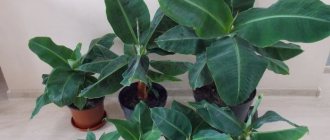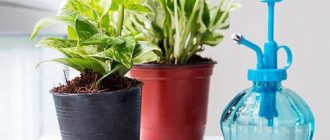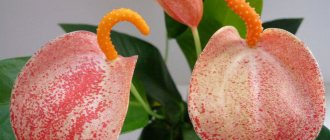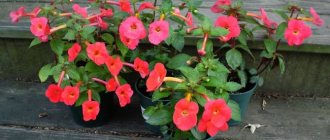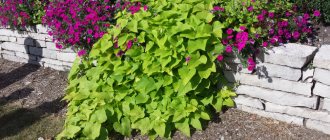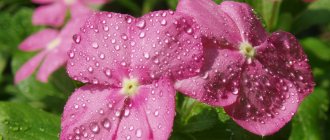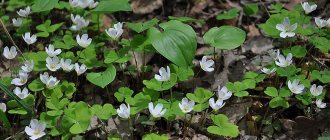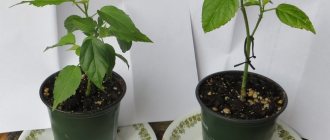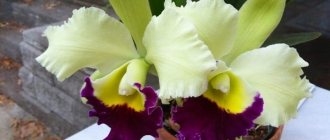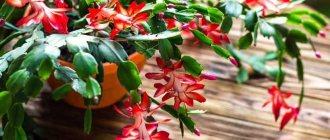The spectacular Haworthia of the Xanthorrhoeaceae family, subfamily Asphodelaceae, is often cultivated as a house plant. Dwarf and miniature succulents prefer well-lit window sills, terraces or balconies, but do not tolerate heat.
The flower received its name in honor of Adrian Haworth, an English botanist, which determined its place in the classification.
Botanical description with photo
Haworthia (lat. Haworthia) does not have colorful leaves and is not rich in flower buds, but the wide range of leaf shapes of the graceful succulent has invariably attracted the attention of gardeners for many years.
Botanical characteristics of the crop:
- The leaves are fleshy, dark green in color, in some species they are covered with white, warty tubercles, the edges are smooth, with “cilia”, denticles or long spines.
- The rosette is basal, of linear and pointed sheaths, which, depending on the variety, are widely spaced or tightly fitted to each other.
- The peduncles are long, it is recommended to cut them off to avoid depletion of the plant.
- The buds are small, white, almost identical in most species, and rarely appear at home.
- Root system - there are 3 types. The first ones are thick, increase in size when moistened, and disappear into the ground on their own when dry. The latter are fleshy and create an extensive network. Still others live in the above-ground part and pull the plant into the ground until the leaves are alive when the dried ones fall off.
What kind of plant is this?
Haworthia is a perennial plant characterized by its small growth. We can say that it is a shrub without a trunk or with a small trunk. In adulthood they can reach 12 cm in height. Many species are characterized by shortened stems that branch well. They also often have daughter rosettes and side shoots. You can learn about the most popular types of Haworthia here.
The leaves of the plant are convex at the bottom. They are tough, leathery, fleshy. They are often characterized by a triangular shape. They can be blunt, elongated or cut off at the end. They are often characterized by a warty surface with a large number of tubercles. They form the transverse rows. The color can be dark green with blue, it can also have brownish shades.
Some species have a transparent epidermis, under which there is aquiferous tissue. Such rosettes can form turfs, which consist of suckers. Flowering is not particularly valuable. The flowers have a cylindrical shape, they are characterized by 6 petals that grow together at the bottom. They are greenish-white or pale pink in color.
Note! The peduncle should be removed in advance, since many species may die after flowering.
Types for indoor growing
More than 100 species of this plant are known to exist. Several species are suitable for growing at home, here are some of them:
- pearl;
- tortuous;
- Cooper;
- dwarf;
- attentuate;
- scaphoid;
- Limofolia;
- mosaic;
- chopped off;
- arachnoid;
- striped.
Read more about varieties and hybrid varieties of succulents for growing on a windowsill here.
Difficulties in growing succulents
Even such unpretentious plants as succulents can sometimes be capricious. For example, there are several main problems that gardeners most often encounter. Let's look at them in more detail:
- change in leaf color, this is due to excess or untimely application of fertilizers;
- leaf rotting is a consequence of exposure to excessively low temperatures;
- curling and drying of the tips of the leaves, which occurs due to exposure to high temperatures and dry air.
- If the plant grows yellow or white leaves, it is a sign of too much light.
With proper care of crops, they will not suffer, but will only delight their owners.
Plant pests
The most dangerous and common pest is the mealybug. Visually they have the appearance of cotton wool. Due to the impact of such a pest, crops begin to develop worse, their growth slows down significantly.
To control such parasites, it is recommended to use insecticide treatments. The most suitable options are “Aktara”, “Mospilan”, “Aktellik”. It should be processed according to the instructions that come with each drug.
If insects have damaged the roots, then be sure to remove the crop from the substrate, wash it, and treat it with a solution of the drug. The plant is then transplanted into a new pot with fresh soil.
Location and lighting
No succulent will grow well in low light. A miniature flower needs bright sun, but without direct rays.
Therefore, it is best to place haworthia on windows facing south, southwest and southeast.
At the same time, we must not forget about its protection in the summer in the afternoon.
Common mistakes
Despite the ease of growing Haworthia, there are the most common mistakes in caring for it.
- With a minimum of light, the leaves of the flower become limp, drooping and are easily damaged even from touching.
- If the plant gets a lot of direct sun, the leaves on it darken and curl. Shade the place.
- This flower can be easily filled. If there is excessive moisture, the leaves become watery, and in the worst case, they rot and turn black at the base.
Avoid these mistakes to ensure your Haworthia always remains beautiful and fragrant.
How often to water and spray at home?
Unlike other succulents, a representative of the Xanthorrhoeae family will not be harmed if watering liquid gets inside its rosette. Moreover, it is recommended to irrigate haworthia using the sprinkling method, while observing the following conditions:
- regular ventilation of the room;
- mineral components in the soil.
Due to waterlogging, the root system of the flower rots, which begins to actively increase its mass in the event of poor irrigation. Water at room temperature is suitable for irrigation. In the summer between procedures, the substrate should dry out by a third, in the winter - completely.
Haworthia - a resident of the African deserts
Unpretentious haworthia looks original in unusual containers
The homeland of Haworthia is the African continent, or more precisely, the Cape Province of South Africa. The plants are found in rocky deserts where it is incredibly hot during the day and the temperature at the soil surface is over 60°C. Under such conditions, haworthias grow immersed in the ground, exposing only the upper part of their fleshy leaves with translucent “windows” through which light barely penetrates, and therefore the hot rays of the sun are not destructive to the tissues inside the flower. The flower also grows in shady places: it can be found among stones, under bushes, in the grass. In this way, the succulent protects itself from being eaten by animals, overheating and excessive evaporation of moisture.
How does she look?
The genus Haworthia includes more than 70 plant species. All of them have fleshy leaves that form a basal rosette. In some species the shape of the leaf blades is pointed, in others the tips of the leaves are blunt or rounded. The color of the plant is incredibly varied: from dark green to reddish-brown. At the same time, under the influence of sunlight, the pigment becomes brighter. The leaves of some species have translucent “windows” at the top, while others are covered with warty white tubercles. The edges of the leaf blade can be either smooth or covered with all kinds of “cilia” and denticles. It is for the rich variety of shapes and colors that haworthia is valued by flower growers.
The flowering of Haworthia, on the contrary, is inexpressive. Small white flowers appear on long stalks in late spring. In indoor conditions this happens extremely rarely. This is probably for the best, since during flowering the plant is very depleted, and some species may even die.
Haworthia blooms inconspicuously
Haworthia is a compact miniature plant, the maximum height of which is only 12–15 cm, the average size of the rosette does not exceed 8 cm. The lifespan is quite long, on average the plant grows for about 30 years, but it may well live longer. In addition, Haworthia produces numerous offspring, annually developing a large number of lateral shoots (children).
How is it different from aloe?
Quite often, striped haworthia is confused with aloe. A distinctive feature of the latter are thin “antennae” up to 1.5 cm long, growing at the tips of the leaf blades. As the plant matures, they dry out. Haworthia does not have such “antennae”. Another distinctive feature by which plants are distinguished is the presence of a pattern on the upper side of the leaf blade; in Haworthia, the outer side of the leaf is rough, and in aloe, both sides are smooth to the touch.
Aloe looks a bit like Haworthia
Types and varieties popular in indoor floriculture
As already mentioned, there are about 70 species in the genus Haworthia. Many of them are successfully cultivated not only in greenhouses, but also at home. Among them are the following:
- One of the most common species grown in captivity is the striped haworthia. The leaf blades are covered with white growths, which are arranged linearly, making them look like a striped pattern from a distance. The size of the rosette is approximately 15 cm.
- There are short spines along the edge of the Haworthia pearl leaf. The white growths in the form of warts are the largest among other species of Haworthia; it is thanks to these snow-white growths that the species got its name. The flowers, unlike other haworthias, are not white, but have a greenish tint.
- The height of the Haworthia Reinwardt rosette is approximately 12 cm. Its leaf blades grow almost vertically, arranged in a spiral, close to the center. The leaves are small, only 3.5–4 cm long, but the peduncle reaches 1 m. Small lime-colored flowers bloom on it.
- It is very similar to the striped haworthia, but the flower is less decorative, since the pattern of dark green growths is almost invisible.
- Haworthia checkerboard (mosaic) leaves are very thick, they are convex on the underside. They grow in a spiral. There are almost imperceptible denticles along the edge of the leaf blades. The plant has a very unusual pattern on the surface of the leaf - a mesh of thin stripes.
- Haworthia limofolia has very hard leaves. A distinctive feature of this species is a pattern of wavy lines, which is mirrored on the underside of the leaf blade.
- Haworthia tertiformis is distinguished by narrower and longer leaves, sharply pointed at the ends. The tubercles are located randomly on the leaf blades, but the pattern is more pronounced inside the rosette.
- Haworthia grassa lacks a stem. The leaves are painted in different shades of green: from light green to emerald. The color depends on the intensity of lighting and the frequency of watering. Along the edge of the leaf blades there is a “fringe” of small processes.
- Haworthia arachnoid is distinguished by thinner “cilia” along the edge of the leaf, which intertwine above the rosette, causing it to look like a fluffy ball of white yarn.
- Haworthia obtuse leaves are very thick and frequently spaced. The diameter of the rosette is about 15 cm. In insufficient lighting, the color takes on a reddish tint.
- Haworthia africa is a low succulent plant (up to 8 cm in diameter) with unusually thick, dark green leaves that have an unusual arrangement. They seem to have cut off ends and an irregularly shaped oval and almost transparent “window”. Small whitish and inconspicuous flowers are collected in a brush.
- A miniature plant is dwarf haworthia (pygmy), the length of its leaf blade is only 1 cm, and the diameter of the plant’s rosette is 5–6 cm. The surface of the leaves is rough to the touch.
- An unusual flower is Haworthia Marginata. Leaves in one rosette have different shades. Adults located at the edges are much darker than juveniles located in the center of the rosette.
- The leaves of Haworthia Atrofusca are reddish in color and become translucent in intense light.
Photo gallery: striped, pearl and other patterns on leaves
Haworthia striped
Haworthia pearl
Haworthia Reinwardt
Haworthia drawn
Haworthia chess
Haworthia lemonfolia
Haworthia tertiformis
Haworthia herbaceous
Haworthia arachnoid
Haworthia obtuse
Haworthia chopped off
Haworthia dwarf
Haworthia marginata
Haworthia Atrofuska
Choosing a pot
Round ceramic pots with rough walls are best suited for growing exotic succulents, since it is very difficult for dried roots to cling to a smooth surface. And this creates a high probability of their rotting.
Also, you should not take containers that are too large, since the soil in them takes longer to dry out, which can cause overflow of the crop.
How to propagate Haworthia Cooper succulent
Several methods are used to propagate such a plant. The simplest is the use of side shoots. For such purposes, you will need to cut a small shoot (necessarily without roots), place it in a moist substrate, and provide a “greenhouse” so that the crop takes root faster. A similar method is reproduction with the help of children. Daughter curtains with small roots also take root quite quickly.
Photo of the Haworthia breeding process by the baby department
The second option is propagation using a leaf. The leaf is carefully cut off, placed in a warm place, and left for 48-72 hours so that it has time to dry well. The dried leaf is placed in sand and covered to form a “greenhouse”. When the first roots appear, the tiny seedlings move to a permanent place of growth.
You can also buy Haworthia Cooper seeds from an online store to grow mature plants. To plant seeds, use the following scheme:
- prepare special soil, for example, perlite, vermiculite, sand, soil for succulents;
- place the substrate in flat and wide containers;
- press the seeds into the soil and cover with cling film on top;
- place the containers in a semi-dark and warm place;
- when seedlings begin to form, move the container to an area with good lighting; the second option is to provide lighting;
- picking is carried out as carefully as possible; the soil is dried in advance.
With a little effort, you can get beautiful and healthy plants in your collection.
Composition of soil for succulents
A representative of the Xanthorrhoeae family does not tolerate acidic soil at all, which is why for cultivation it is better to choose a substrate with a weak or neutral reaction. The soil should not contain more than 50% organic matter. Otherwise, it will quickly acidify.
A mixture of pumice and lava particles, with a small amount of nutritious soil, is ideal. You can also make the mixture yourself from 3 parts peat, coconut fiber and sand, 1 part clay and 2 parts expanded clay.
History and description of striped Haworthia
Haworthia striped received its name in honor of the scientist Adrian Haworth, who explored the flora of Africa and was the first to introduce humanity to this unusual flower (Figure 1).
The plant’s homeland is considered to be South Africa, or rather its driest regions. The root system of the crop is developed in such a way that Haworthia can receive the required amount of nutrients, even growing on poor rocky or sandy soil. Quite often, the succulent is also found under spreading trees and shrubs.
Figure 1. The leaves of the plant are highly decorative
The main feature of Haworthia is the presence of fleshy, succulent leaves. They are ways to accumulate and retain water, which gives the plant the ability to survive in extremely dry climates. There are quite a lot of types of culture, and they differ only in the shade of the leaves and the presence of tuberous growths of a pearl shade.
Another characteristic feature is the almost complete absence of a stem. In this case, the rosette of leaves can reach 10 cm in diameter. The main decorative value is the striped leaves of the plant, although if comfortable conditions are created, the haworthia may bloom. Unfortunately, its inflorescences do not represent decorative value and only weaken the culture, so it is recommended to cut off the flower stalks immediately after they form.
When to replant after purchase and more?
After purchasing, the haworthia must be immediately moved to another pot, since the transport soil is not suitable for its development, and the roots of the crop may be damaged.
Adult crops are transplanted to a new habitat no more than once every 2-3 years.
Step-by-step instruction:
- A layer of mineral mixture is poured into the bottom of a suitable pot so that the root system barely reaches it.
- Next, the plant to be moved is held above the center of the pot, while filling the sides with substrate.
- After such manipulation, the socket should be flush with the ground surface.
- The succulent is watered 2 days after transplantation, and the released liquid is immediately removed from the pan.
How to transplant?
The pot should be wide, but not too deep. After replanting, the soil should be covered with gravel. Please note that haworthia will thrive if the soil is created in the form of a hill. Watering can be carried out around the edges, since the plant requires a little time to adapt to a new location.
Excessive watering during planting can lead to rotting of the horse system. The plant should be replanted in spring.
If the soil is too damp and there is stagnation of water in the pot, then the plant needs to be pulled out and all dead roots removed. You can also cut off the bottom of the stem if rot is present.
Important! Replanting can be painless for the plant if you adhere to this requirement - you should not water heavily. You need to do it only after the soil looks healthy.
When and why to do this?
Haworthia should be repotted as needed when the pot becomes too crowded.
Young plants need to be replanted 2-3 times every year. It is optimal to transplant in the spring, in March. The plant does not need a large pot. But it is worth paying attention to the drainage layer, since it is the key to good growth due to the fact that it does not allow water to stagnate.
Priming
Haworthias are suitable for a mixture of leaf soil and turf, sand, peat and humus. You can also add brick chips in small quantities. Often they use a store-bought mixture for succulents and cacti.
The soil for haworthias should absorb moisture well without retaining it. It should be porous, loose and not compacted. When moist, it should allow the roots to breathe. A mixture of 4 parts earth and 6 parts baking powder meets all these requirements.
Fine gravel acts as a loosening agent. However, you can also choose expanded clay, perlite, pumice, charcoal, brick, foam. A nutrient mixture containing different sand particles is suitable for the roots.
Below we watch a video about transplanting into gravel:
Pot
The container should be low, wide and shallow. If it is too large, the plant will begin to develop in depth rather than upward. A cramped pot may cause the leaves to shrink.
REFERENCE! When growing at home, it is better to choose a round plastic pot, since in a square one the roots begin to rot.
Stages
Transplantation as a stage of haworthia propagation is carried out in stages:
Take a wide, shallow container. It must be round so that the roots of the succulent can develop normally.- The soil should be neutral or slightly alkaline. Under no circumstances should acidic be used. It should contain sand, leaves, and turf soil.
- Since the plant does not like stagnant water, good drainage is needed. Holes are made at the bottom of the pot, which will regulate the amount of moisture.
- The plant must be inspected after being removed from the pot. The presence of damaged and dry roots indicates that they need to be cut off and the cut areas treated with charcoal.
- After transplanting into a new container, the plant needs to be watered.
Reproduction
The seed propagation method is usually used by professional flower growers who grow hybrids. For amateurs, vegetative methods are more preferable.
Root with leaf
A leaf plate up to 10 cm long is cut from the mother plant, the cut is treated with activated carbon, dried and rooted. The first watering is carried out only after 3 weeks.
Seeds
Seeds are laid out on the surface of wet peat or sand. Then the material is covered with glass or cling film and wait for germination, exposing the container to light at a temperature of +20...+25 degrees.
Separate baby
This method is most conveniently carried out simultaneously with transplanting the crop, because some children already have their own roots and can be placed in ready-made containers.
Daughter rosettes without roots should be separated with a blade or sharp knife, dusted with activated carbon and placed in cups with wet sand or perlite. After the appearance of the vegetative organ, 1-2 tbsp is poured into each container. spoons of water, and after 2 weeks they are transferred to the substrate familiar to the culture.
Care after transplant
After transplantation or propagation, the haworthia needs to be placed in a place where direct sunlight does not reach. The optimal temperature in summer is considered to be from 15 to 25, and in winter within 10-12 degrees.
It is important to water 1-2 times a week, but water should not be allowed to get into the center of the bush. If overwatered, the roots will begin to rot, which can lead to the death of the haworthia.
This succulent needs to be fertilized once a month. At the same time, you can use fertilizers for ornamental plants or a weak solution of mineral fertilizers.
The variety of species and varieties of haworthias makes it possible to find “your” succulent or create an original collection from several specimens. On our website you will find tips on caring for this succulent, and also learn about varieties such as:
- Haworthia Coopera (truncata) - description and care.
- Haworthia Striped - growing at home.
Possible problems with leaves and how to revive them?
If the maintenance rules are not followed, haworthia may lose its attractiveness.
What to do if you are stretched out?
In low light conditions, the rosette stretches out and becomes loose.
By satisfying your haworthia's need for sunlight, you will quickly improve the situation. It could also be due to a lack of nutrients or a small pot. The first problem is solved by feeding, the second by transplanting.
The ends are drying out
The air in the room where the flower is located is too dry. To increase the humidity level, it is recommended to place a container of water next to the pot.
Turn red or yellow
This problem indicates that the crop has developed sunburn. The plant urgently needs to be shaded with a curtain. Also, excess fertilizer may be to blame - you will have to update the substrate.
They rot and turn black
The essence of the problem lies in the air temperature, which is below normal. Damaged plates should be removed. At the same time, adjust the temperature regime at the same time.
Diseases and pests - table
Haworthia is very rarely bothered by pests, and the plant practically does not get sick, which is an undoubted advantage of the flower over other succulents. But still, sometimes Haworthia is exposed to fusarium or aphids, spider mites or scale insects from other plants can spread to it.
| Pests/diseases | How do they manifest themselves? | How to fix | Prevention measures |
| Root rot (fusarium) | At the base, the leaf blades turn black and are easily separated from the rosette | Replant the plant in fresh soil. When replanting, cut off all rotten roots and treat them with a solution of any fungicide. | Water the plant properly, do not allow excess moisture. After watering, immediately drain the water from the pan. |
| Shield aphid (scale insect) | Brown plaques appear on leaf blades, then the leaves dry out and fall off |
| Check neighboring plants infected with scale insects and isolate them immediately. |
| Root mealybug | The leaves become deformed, change color, and whitish flakes and a waxy coating appear on the soil surface. |
|
|
Photo gallery: diseases and pests
Root rot can kill a plant
Scale insects are a very insidious pest.
Root bugs are a big threat
Difficulties in keeping haworthia
Elongated leaves, looseness and elongation of the rosette are a lack of light. The plant needs to be moved to a western or eastern window. If haworthia is grown in composition with other plants, then it is placed at the base of large ones.
The leaves are elongated, the edges are bent, the growths become dull - the temperature is too high in winter. It is necessary to reduce the temperature to 10 ° C
During the dormant period, the ends of the leaves dry out and curl at the edges - excess heat and dryness. Necessary protection of the plant from hot air. Glass or placing the pot in a tray with wet pebbles will help.
The flower changes shape and grows in length - it needs replanting and feeding. Be sure to separate the children. If brown spots appear on the leaves, shade the plant.
An interesting property of Haworthia is that it requires light for 3-4 hours. Accustoming to the sun begins gradually in the spring to avoid burns.
The lower leaves come off easily and are limp - the plant is flooded. It is necessary to stop watering until the plant is completely restored.
The color of the leaves changed to pale, yellow, red - excess fertilizer. You can feed once a month. Fertilizing with fertilizers with a high nitrogen content is unacceptable.
The leaves turn black and rot - the soil is very wet, the temperature and air are very low. The plant is urgently brought into the house.

